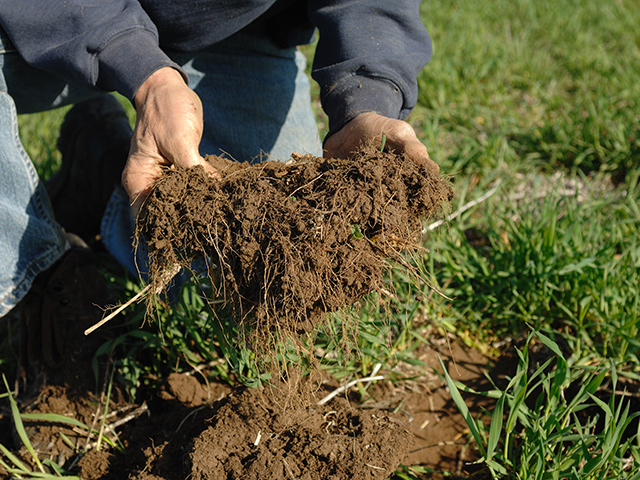Group Wants New Conservation Program
Farm Groups Join to Seek at Least $100 per Acre for USDA Conservation Program
OMAHA (DTN) -- A coalition of agricultural organizations, backed by funding from a handful of foundations, has formed a new group to champion the creation of a voluntary USDA climate change program to pay farmers $100 an acre or more to apply conservation practices on their farms.
Calling themselves Rural Investment to Protect our Environment (RIPE), the group seeks minimum $100 per-acre payments under what they call the RIPE100 plan that would "reward farmers for the total public value of their conservation practices." Going beyond carbon sequestration, the group said, "the voluntary federal program would pay for improved soil health, cleaner water, biodiversity and other environmental services."
The group's proposal seeks a new USDA conservation program with new funding for their proposed program.
"This is a first-of-its-kind policy that will help farmers invest in environmental improvements while mitigating the risk of implementing a new practice," said Brandon Hunnicutt, RIPE steering committee chair and Nebraska farmer who is active in state and national commodity associations.
Looking at current carbon market payments, which average about $15 for a ton of carbon sequestration, RIPE makes the case that farmers should be paid more money to implement climate-smart conservation practices. Climate policies increase input costs, the group stated, and current incentive payments do not cover the costs of implementing practices to lower emissions and sequester carbon. A $100 per-acre price floor -- or $100 per-animal unit -- would reflect the public value of conservation practices, RIPE stated.
To put the $100 an acre plan into context, if USDA were to create a new program and enroll 100 million acres, it would cost more than $10 billion annually.
P[L1] D[0x0] M[300x250] OOP[F] ADUNIT[] T[]
USDA's entire spending on conservation programs in fiscal year 2020 was about $8.2 billion, including the three major programs: the Conservation Reserve Program (CRP) at $2 billion; Environmental Quality Incentives Program (EQIP) at $1.75 billion; and USDA's Conservation Stewardship (CSP), which cost a record $2.2 billion in Fiscal Year 2020.
CSP has about 93.5 million acres of current active contracts going back to 2010. Before the 2018 farm bill, CSP paid $18 an acre, but now pays based on specific practices on enrolled ground. The 2018 farm bill pared back the scale of enrollment and payments for CSP.
CRP, which idles land for 10- to 15-year contracts, has 20.5 million acres enrolled paying an average rate of $83.36 an acre. General CRP sign up pays about $54 an acre.
Currently, the conservation language in the House budget reconciliation bill called for increasing spending for $28 billion through 2030, or a boost of about $3.5 billion a year. Among the proposals in the bill is a plan that would pay farmers up to $25 an acre to plant cover crops. However, as Democrats in Congress negotiate the overall size of the reconciliation bill, the conservation proposals could be pared down.
Private carbon credit programs, which are still small in numbers, are paying farmers on average about $15 a ton, which breaks down to even less per acre. RIPE stated the group backs private carbon markets, in addition to the development of a far more expansive government program.
RIPE takes a more aggressive strategy for climate-smart practices than the coalition of more than 80 farm groups called the Food and Agriculture Climate Alliance (FACA). FACA last week was encouraged by a new USDA proposal announced to begin new pilot programs that will encourage farmers to implement more climate-smart practices on working lands.
Aliza Wasserman-Drewes, executive director for RIPE, told DTN the group looked at the costs of implementing new conservation practices and the effects those practices would have on input costs. RIPE looked at the overall environmental benefits to the public in terms of reduced emissions as well as improvements in water quality. Along with that, President Joe Biden had initially championed investing $500 billion in climate practices and RIPE's strategy would only be about 8% of those costs.
"So, we think 8% of national climate spending going to farmers to provide a reasonable return for voluntary stewardship that delivers public benefits that far surpasses the value is actually quite a very reasonable and practical figure," Wasserman-Drewes said. "It also opens the door for a bipartisan approach to climate policy."
Wasserman-Drewes noted polls have shown only about 40% of the population in Republican communities support using taxpayer dollars to address climate change, but support increases to 77% when it is viewed as helping farmers adjust to climate. Support increases to 93% when the public learns the funds are going to help improve water quality and soil health, she said.
"So, the public is very supportive of government programs that support farmers to provide environmental benefits, even within rural Republican communities," she said. "We think it's just a matter of the farmers have been supported to ask for this approach. But the public supports it, and policymakers' door are open."
The RIPE group has members of its board and advisory committee from several agricultural organizations. Specific groups that are part of the RIPE steering committee include the Iowa Corn Growers Association, the National Black Farmers Association, Arkansas Rice Federation, North Dakota Grain Growers Association, Minnesota Farmers Union and North Dakota Farmers Union. Grants that helped start the group came from a handful of foundations listed on RIPE's website.
RIPE's website: https://www.riperoadmap.org/…
Chris Clayton can be reached at chris.clayton@dtn.com
Follow him on Twitter @ChrisClaytonDTN
(c) Copyright 2021 DTN, LLC. All rights reserved.




